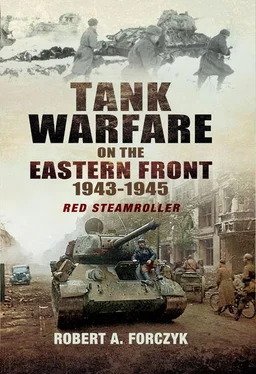Operation Kutusov , 12 July–18 August 1943
As soon as Rokossovsky noted that Model had suspended his offensive, he notified the Stavka, which ordered the Central, Bryansk and Western Fronts to prepare to begin Operation Kutusov , the pre-planned counter-offensive, as soon as possible. This operation had been planned in detail since the spring and it intended to crush the German forces in the Orel salient by means of a multi-front attack from three directions. {130} During the lull, the Stavka had deployed great resources in the Western and Bryansk fronts to support Kutusov . Both Rybalko’s 3rd Guards Tank Army (3 GTA) and Badanov’s 4th Guards Tank Army (4 GTA) were scheduled to reinforce the offensive once it got going. However, two vital prerequisites for Kutusov ’s success had not been met: Model’s armoured reserves were supposed to have been ground to pulp in Pukhov’s killing fields, but they were not, and the VVS was supposed to have gained air superiority over the Orel salient, but it had not. Furthermore, all three Soviet fronts were supposed to attack simultaneously, but Rokossovsky’s battered Central Front needed several days to recover. Consequently, Operation Kutusov was conducted in an uncoordinated style that allowed Model to shift his resources around to deal with one threat, then another.
Only one day after Model suspended his offensive, reconnaissance units from both the Western and Bryansk Front began probing aggressively against 2.Panzerarmee’s (PzAOK 2) front on the northern and eastern sectors of the Orel salient. The PzAOK 2 was holding a 250km-long front with 12 infantry divisions in the XXXV, LIII and LV Armeekorps. The only mobile forces available to PzAOK 2 was the 5.Panzer-Division and the 25.Panzergrenadier-Division, both under-strength. Although PzAOK 2’s troops had held most of their positions for over a year and were well-protected by mines and entrenchments, the army had received few replacements since priority had gone to AOK 9 to build it up for Zitadelle and thus, the German front on the northern side of the Orel salient was quite brittle.
At the last moment, just before Kutusov was set to begin, the Germans saw what was coming and Model began transferring anti-tank assets to PzAOK 2, including some of the remaining Ferdinands and the new Hornisse tank destroyers. General der Infanterie Lothar Rendulic, commander of the XXXV Armeekorps, created a particularly strong anti-tank defence on the eastern side of the salient. Despite his lacklustre performance during Operation Gallop , General-polkovnik Markian M. Popov had been given command of the Bryansk Front and was designated as the main effort of Operation Kutusov . However, the level of effort he put into planning and organizing his forces for battle was characteristically deficient. At 0330 hours on 12 July, both the Bryansk and Western Fronts commenced their offensives with a massive 150-minute artillery barrage, conducted by eight artillery divisions. {131} The German front-line positions were pounded like they had never been pounded before – this was the first of a new type of Soviet offensive that dwarfed everything previously attempted by the Red Army.
As the artillery fire shifted, the Soviet assault troops advanced. Popov committed seven rifle divisions from the 3rd and 63rd Armies against two of Rendulic’s infantry divisions and succeeded in pushing 5km into the German defences before his attack ran out of steam. Soviet air cover from 15th Air Army (15 VA) over Popov’s troops evaporated when Luftflotte 6 arrived over the battlefield and shot down 50 VVS aircraft. This was repeated on the second day of Popov’s offensive, when Luftwaffe Fw-190 fighters destroyed nearly 50 Il-2 Sturmoviks from 15VA, depriving Popov of his close air support. {132} Nonplussed by this loss, Popov decided to commit his armour to create a breakthrough, sending in over 300 tanks, including three regiments of KV-1 heavy tanks. Back in 1939–40, the KV-1 had been designed as a breakthrough tank and this was the type of deliberate attack that it had been intended to shine in, but now in 1943 the KV-1 was just a large, slow target. Rendulic had created an effective killing zone near the village of Arkhangel’skoye, with nine Hornisse 8.8cm self-propelled guns from Panzerjäger-Kompanie 521 and some of the new towed 7.5cm Pak 41, which fired PzGr 41 Hartkern (hard-core) rounds with tungsten penetrators. [33]Advancing in broad daylight across open fields, the KV-1s from Podpolkovnik Yakov F. Dligach’s 114th Tank Regiment were shot to pieces long before most got near the German lines and the attack collapsed. The Battle of Kursk was the swan song for the KV-1 heavy tank and afterwards it was phased out in favour of a new heavy tank. Nevertheless, Popov committed General-major Mikhail F. Panov’s 1GTC, which was intended to be his exploitation force, to reinforce the 3rd Army’s attack and it was able to gain some ground, at great cost.
Rendulic committed his corps reserve, the 36.Infanterie-Division (mot.) to delay Panov’s 1GTC and Model agreed to transfer the 2. and 8.Panzer-Division to this sector. However, this was not Model’s only crisis. General Vasily D. Sokolovsky’s Western Front had attacked the LIII Armeekorps near Ulyanovo with the heavily-reinforced 11th Guards Army (11 GA) under General-polkovnik Ivan Bagramyan. In this sector, everything went right for the Red Army. Bagramyan massed six of his rifle divisions and several guards tank brigades, supported by the 8th Artillery Corps, against a single German division – the 293.Infanterie-Division. This unit was hard-hit by the concentrated Soviet artillery preparation, then bombed by the 1st Air Army (1VA). Since Luftflotte 6 had committed all its resources to stop Popov’s Bryansk Front, it had nothing left to prevent 1VA from achieving air superiority over this sector. When Bagramyan’s infantry attacked with tank support, the 293.Infanterie-Division collapsed and the Soviets surged forward. The Germans had one chance to stop or delay Bagramyan’s breakthrough, since Generalmajor Ernst Fäckenstedt’s 5.Panzer-Division (with 100 tanks) was deployed only 30km away in a reserve assembly area. The LIII Armeekorps immediately requested Fäckenstedt to reinforce the endangered Ulyanovo sector, but instead he took his time assembling his division and then elected to move toward the right shoulder of the Soviet breakthrough, rather than meet it head-on. Fäckenstedt’s feckless action was the result of his lack of command experience, since he was a career staff officer who was pressed into command of a Panzer-Division due to the lack of other qualified candidates. Germany’s panzers in 1943 were no longer led by the likes of Rommel or Guderian, but oftentimes by mediocrities such as Fäckenstedt. Since Fäckenstedt did not immediately counter-attack Bamgramyan’s breakthrough, the 11 GA was able to advance more than 10km on the first day of Kutusov . Adding to the crisis atmosphere, the 61st Army from the Bryansk Front staged a separate attack north of Bolkhov, which managed to cross the Oka River and create another small breach in PzAOK 2’s front. Shortly thereafter, the Soviets inserted the 20th Tank Corps into this bridgehead.
Model began to redistribute his armour from the Zitadelle battlefields to stop the offensives of the Bryansk and Western Fronts, but it was not until 14 July that Hitler gave him authority over all German forces in the Orel salient. Assuming that Fäckenstedt’s 5.Panzer-Division would delay 11 GA, Model decided to focus first on defeating Popov’s Bryansk Front. He transferred 26 of the remaining Ferdinands to Rendulic’s XXXV Armeekorps and requested all Luftwaffe air support to concentrate in this sector. He also sent the 12.Panzer-Division to contain the 61st Army’s attack. The Ferdinands from Panzerjäger-Abteilung 653 were deployed in excellent defensive positions and when Popov’s armour attacked again on 14 July, their long 8.8cm guns picked off 22 enemy tanks at long range. {133} Popov’s advance was slowed to a crawl.
Читать дальше








![John Stieber - Against the Odds - Survival on the Russian Front 1944-1945 [2nd Edition]](/books/405234/john-stieber-against-the-odds-survival-on-the-russian-front-1944-1945-2nd-edition-thumb.webp)



